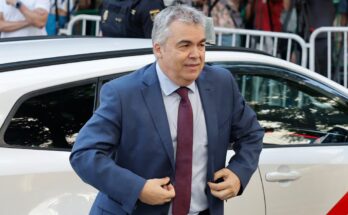A month before the dictator’s death, on October 20, 1975, Antonio Piga received a visit from Franco’s personal doctor, Vicente Pozuelo, in his hospital office, who warned him of the extreme seriousness of the Head of State: “Franco is very serious and I have come to ask you to coordinate the operation to preserve the body after his death”. We remember that he asked for maximum discretion and total availability. The organization of the team essentially consisted of being reachable 24 hours a day and living during that period attached to two black suitcases, “large and very ugly”, with all the material necessary for embalming. From surgical gowns and instruments to liquids and cadaveric makeup. “I had them in the trunk of my car all that time. My big worry was that my car would be stolen with everything in it.”
Piga was 35 years old at the time and was the director of National Center for Surgical Specialties. Today, at 86, four years older than Franco when he died, he reflects with a different perspective on that assignment: “I was young and had always lived under the Franco regime. I think it affected me more from a philosophical point of view than from a medical one because I had already seen many corpses in my professional career, but when I saw Franco’s body in front of me, so old and worn out, I thought that death ends up equaling everyone.”
Franco’s embalming was not easy, the leader had undergone numerous operations and his vascular system was severely damaged. One of the concerns of Dr. Piga and his team was that the embalming fluid be well distributed and that it hardens the entire body equally. The operation was carried out in less than two hours and was carried out at the hospital in La Paz, where the team of medical examiners entered around 11.30pm. on November 19th. For this reason he has always maintained that Franco died on the 19th and not, as the official version says, on November 20th at 5.25 in the morning. “When we arrived, the leader had been dead for several hours. They made us sign a paper at the end of the surgery and we had the exact time put there.”
From this embalming not only was the preservation of the corpse expected, but there was also a very important aesthetic part. The body would remain on public display for several days and would also be broadcast on television. Piga called a nurse from the Institute of Forensic Anatomy, Antonio Haro Espín, who collaborated with the American army on bases in Spain to prepare American soldiers who died by accident or natural death: “He had a make-up that didn’t exist here and which was widely used in the United States, which has the habit of putting make-up on corpses. We did a more sober one that seemed more natural to us.”
Antonio Piga spent those days waiting for Franco’s body. “The next day they called us because a drop had appeared on his face. The lights of the burning chapel heated the body and, in combination with the cold outside, evaporation and subsequent condensation occurred. With a cotton ball I removed the drop and it never reappeared.” Once the problem was solved, the forensic team moved to the Valley of the Fallen where Francisco Franco was buried.


